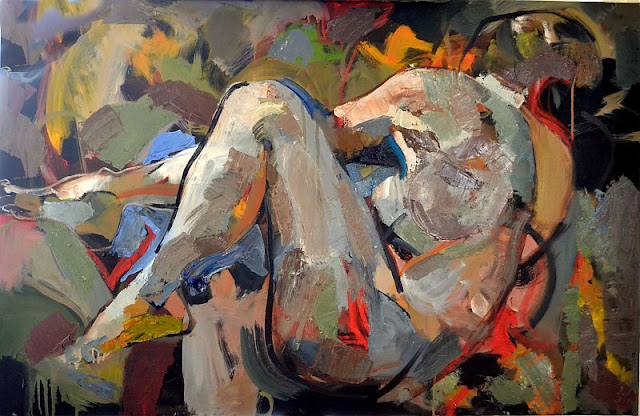Part 9
of an interview series in which I invite artists to respond to six questions
about art, process, and creativity
(Part 1, Part 2, Part 3,Part 4, Part 5, Part 6, Part 7, Part 8, Part 9, Part 10, Part 11, Part 12) . Today's artist is painter and printmaker Thomas Bennett, who lives in Brooklyn, New York.
 |
| "Guarded Sin," 2012, oil over monotype on paper, 16" x 20" |
Philip
Hartigan: What medium/media do you chiefly use,
and why?
Thomas Bennett: I'm a painter and I work in two main media: oil on various supports and the monotype. Oil paint has been my main medium since my father introduced it to me as a child. I use multiple supports and grounds, from canvas to plastic to composite board to paper. The other medium I am strongly connected to is the monotype, the unique one-off print. It's painting and printmaking in one. I use oil based inks and oil paint on plexiglass, then pull a one-of-a-kind print after transferring it to paper through an etching press. I discovered the exciting spontaneity of the monotype in art school, and have been in love with it since. What I've been exploring recently is the reintroduction of oil paint back into a finished monotype print on printmaking paper. These can be considered reworked monotypes or oil paintings or mixed media, for that matter.
Philip Hartigan: What piece are you currently working on?
Thomas Bennett: I
just finished an oil over monotype on paper entitled “Unfollow.” I'm also
working on a larger oil on canvas piece,
in its first stages.
 |
| "Unfollow," 2012, oil on monotype on paper, 18" x 12" |
Philip Hartigan: What creative surprises are happening in the current work?
Thomas Bennett: I've
been exploring the interaction of the abstract with the representational - and
the existential space that results - for the last few years. In the piece I
finished last night I found myself straddling that place between discovery and
misplacement of that ab/rep relationship. The representational form may have
shown its muscle too much, but these pieces are all an exercise and discovery.
Philip Hartigan: What other artistic medium (or non-artistic activity) feeds your creative process?
Thomas Bennett: My process is fed by virtually all sorts of things I experience in everyday life. What's important most of all for me is getting into the studio and working: whether it's playing with photography, experimenting with various media, drawing or doing small studies in various plastic mediums. The action results in discoveries that lead to ideas.
 |
| Limbs, 2012, oil on canvas, 31" x 46" |
Philip
Hartigan: What's the first ever piece of art you remember making?
Thomas Bennett: The first thing I remember making was probably a drawing of a face when I was 3. My father told me later he looked at the eyes I had rendered with irises and pupils and he said to himself: "This kids' going to be an artist."
Thomas Bennett: The first thing I remember making was probably a drawing of a face when I was 3. My father told me later he looked at the eyes I had rendered with irises and pupils and he said to himself: "This kids' going to be an artist."
Philip Hartigan: Finally, and you can answer this in any way that's meaningful to you: why are you an artist?
Thomas Bennett: Making art was all I ever wanted to do. I cannot remember not needing to draw and to make marks. I can't tell you why. I can only say it was and is like breathing.